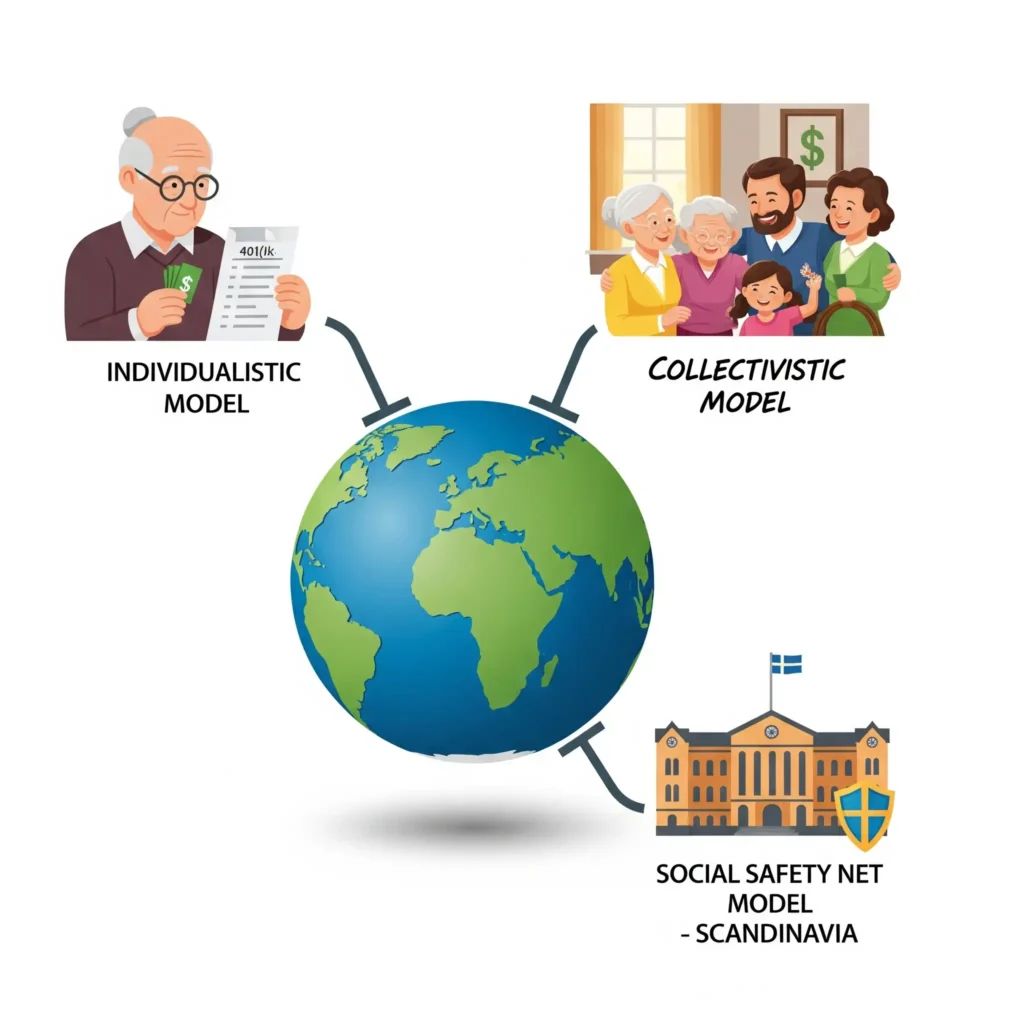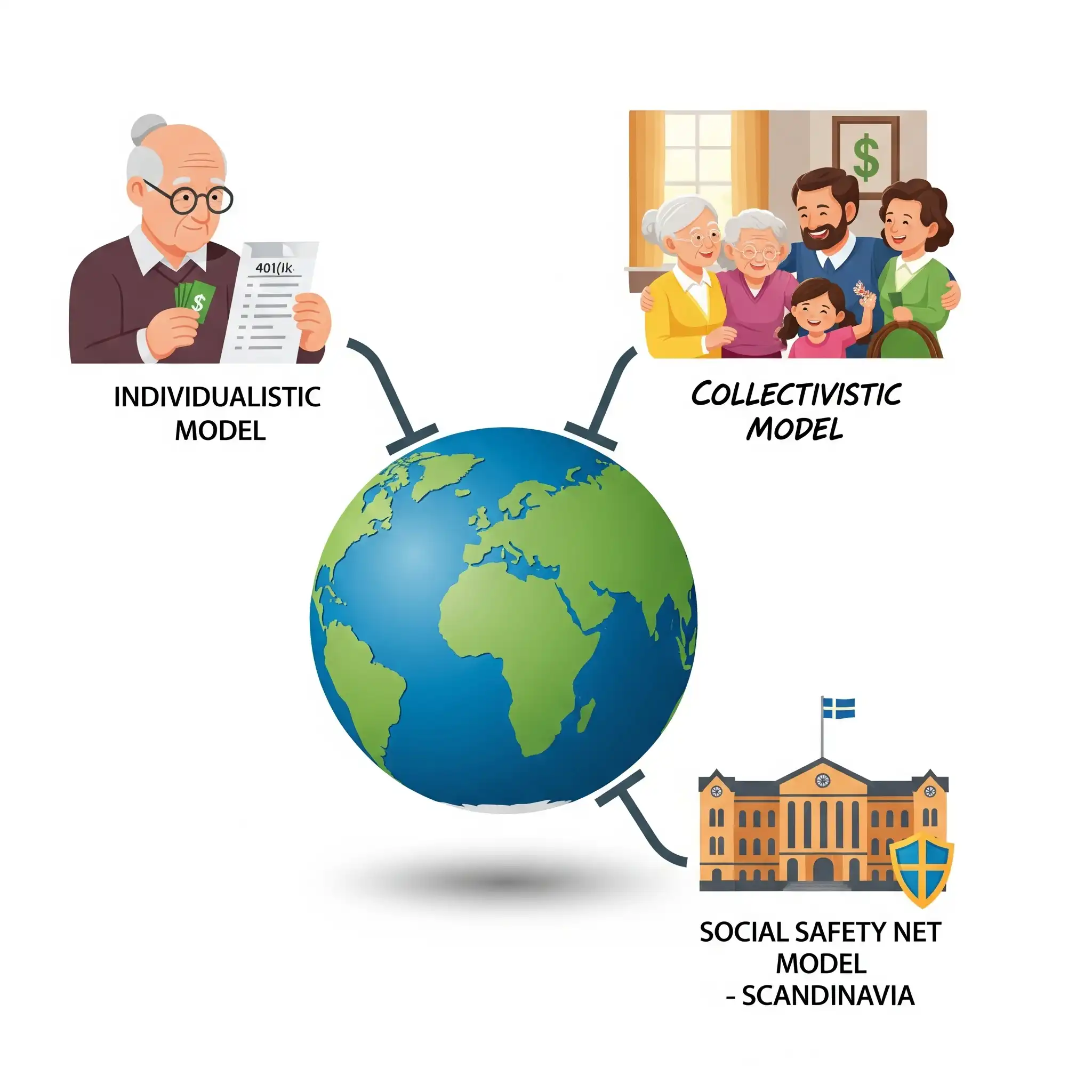Contents
Beyond the 401(k): How Retirement is Viewed Across Different Cultures
Audio Podcast on Global Views on Retirement and Financial Planning
In many Western countries, the concept of retirement is heavily individualized, often defined by personal savings, investment accounts, and government benefits like Social Security. We talk about the three-legged stool and focus on self-sufficiency. However, this is not a universal perspective. Around the world, different cultures view aging, work, and family support through unique lenses, leading to diverse approaches to the post-work years. Exploring these differences can provide valuable perspective on our own financial planning approaches.
Individualism vs. Collectivism: The Core Difference
A major cultural distinction lies on the spectrum between individualism and collectivism.
- Individualistic Cultures (e.g., USA, UK, Western Europe): The emphasis is on the individual’s responsibility to fund their own retirement through personal savings and formal social security systems. It is generally not expected that adult children will financially support their parents in old age. The goal is financial independence from family.
- Collectivistic Cultures (e.g., many parts of Asia, Africa, Latin America, Southern Europe): The family unit is the central pillar of support. It is often a deeply ingrained cultural expectation that adult children will care for their aging parents, both financially and physically. Multi-generational households are common, and the concept of saving in a formal, separate “retirement account” may be less prevalent or a more recent development.

Examples of Different Cultural Approaches:
- East Asia (e.g., China, Japan, South Korea): Traditionally, the principle of filial piety places a strong duty on children to support their elders. While modern economic pressures and urbanization are changing this, the role of family in retirement (Link to 3.27 when created) remains significant. Formal pension systems are now common, but family support is still a major piece of the puzzle.
- Southern Europe (e.g., Italy, Greece): Strong family ties often mean that retirees live with or are heavily supported by their children. Multi-generational households are more common than in Northern Europe or the US, blending family life with elder care.
- Scandinavia (e.g., Sweden, Denmark): These countries feature a highly individualistic approach but with a much stronger emphasis on robust, comprehensive government social safety nets. Citizens pay high taxes in exchange for extensive public pensions and healthcare, reducing some of the individual savings burden compared to the US model.
- Many Parts of Africa and Latin America: With strong community and family ties, informal support systems are often the primary source of security for the elderly, especially where formal pension systems are less developed or accessible.
Lessons We Can Learn:
Viewing retirement through different cultural lenses doesn’t mean one approach is definitively “better” than another, but it offers valuable insights:
- The Importance of Community: The strong social and family fabric in collectivistic cultures highlights the non-financial needs of retirement – combating loneliness and maintaining a sense of belonging.
- Diversifying Support: While self-sufficiency is a worthy goal, understanding the power of family and community as a support network (even if not purely financial) is important.
- Open Communication: The explicit expectation of family support in many cultures underscores the need for clear communication about retirement plans, needs, and capabilities in all cultures.
Conclusion
The American/Western model of a self-funded, highly individualized retirement is just one way of approaching the later stages of life. Across the globe, retirement is shaped by a complex interplay of personal savings, government programs, and deeply ingrained cultural values about family and community responsibility. Understanding these diverse perspectives enriches our own view of retirement, reminding us that a truly secure and fulfilling later life is built not only on financial assets but also on strong social and familial connections.

👋 Hi, I’m Jaiveer Hooda, the content creator behind Grow Your Money Smart!
I’m passionate about exploring the world of personal finance and sharing actionable insights to help you manage debt, plan for a secure retirement, and create passive income streams. 💡 My goal is to simplify complex financial topics and empower you to make smarter money decisions.
Let’s grow your wealth together, one smart move at a time! 💸
